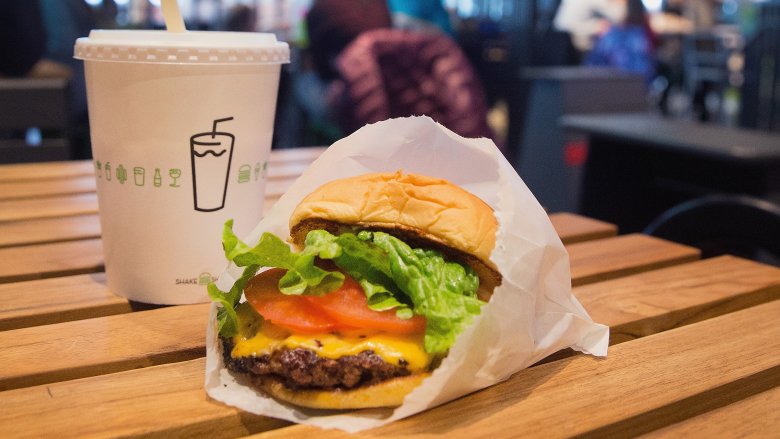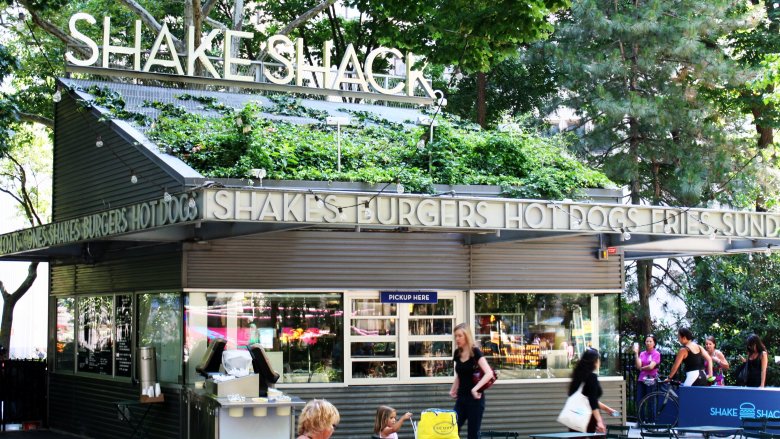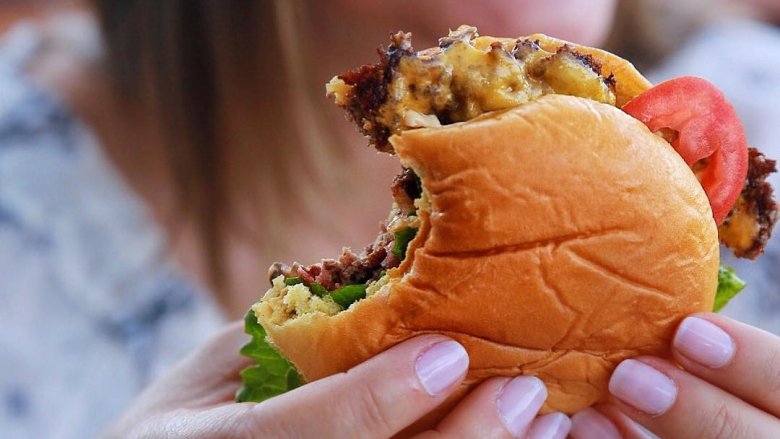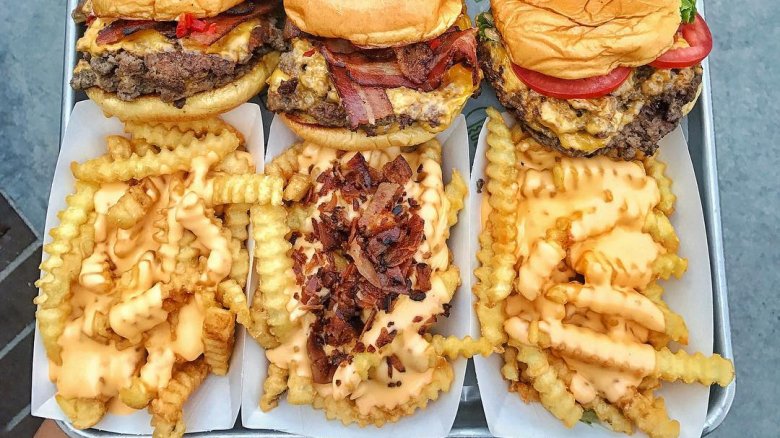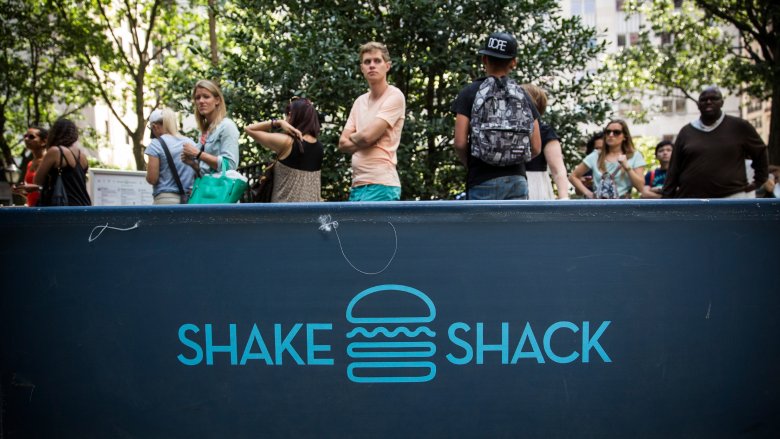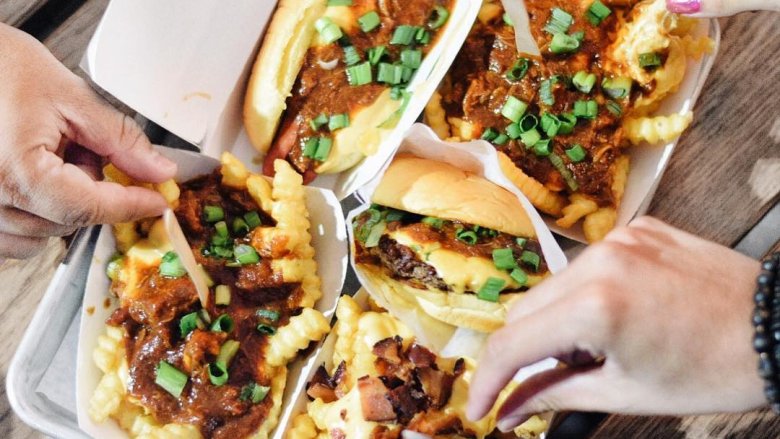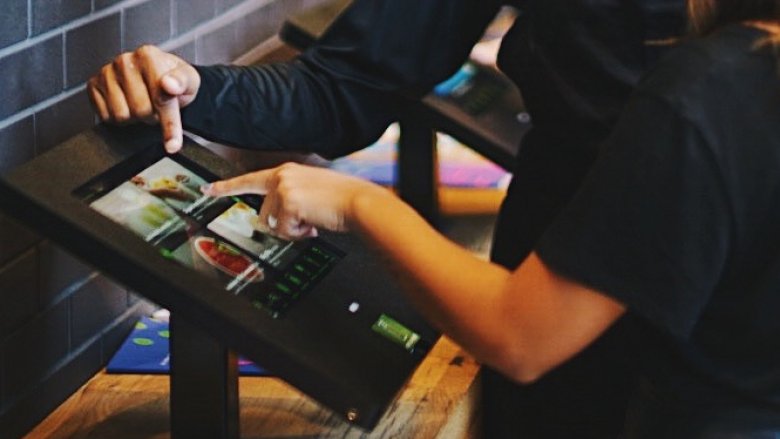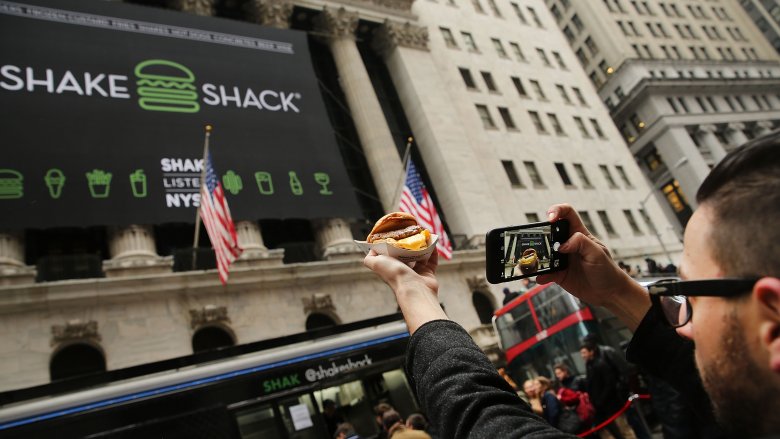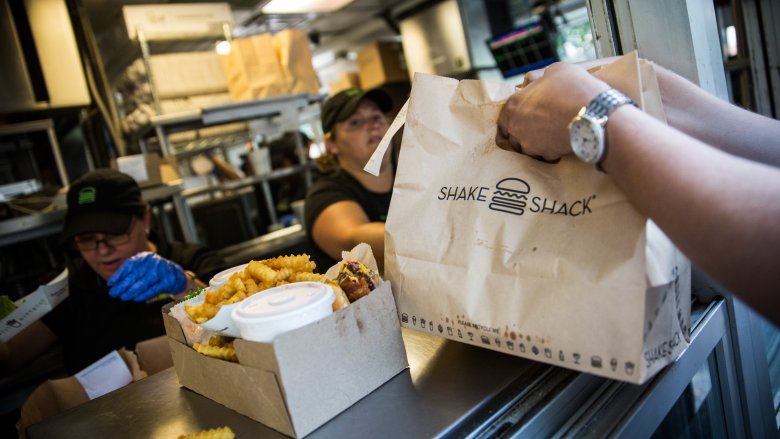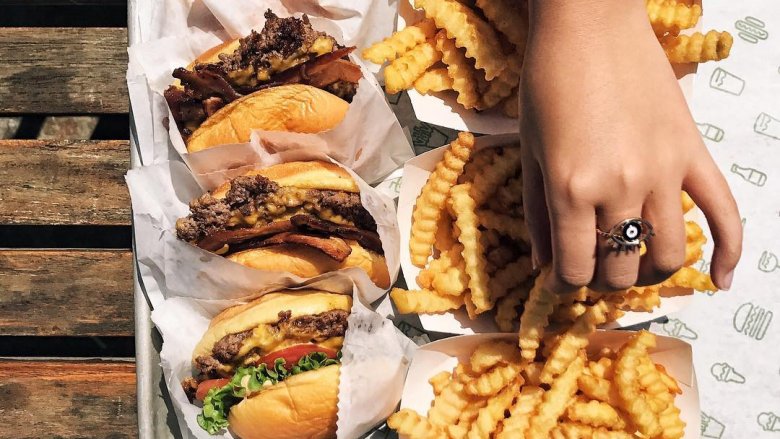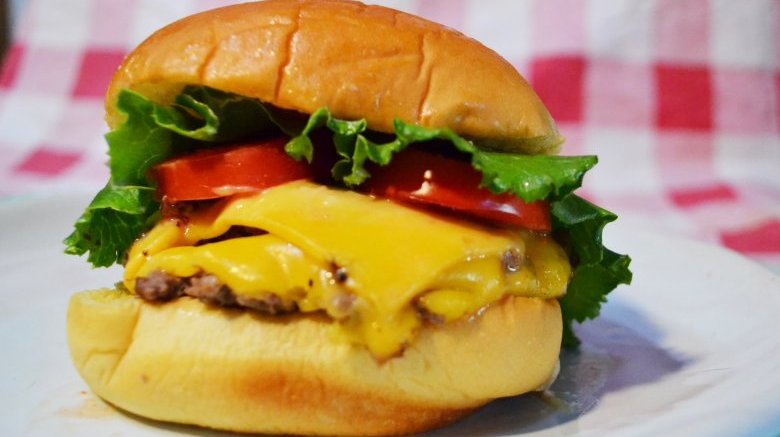Secrets Shake Shack Doesn't Want You To Know
Hungry for a burger, but don't want to stoop down to Dollar Menu standards? Shake Shack is the answer for many. The quick service burger, hot dog, and frozen custard restaurant has been in service for over 17 years, and doesn't show signs of slowing down. It consistently ranks high on lists of the best burgers in America, and part of its signature "look" includes bright green lettering, crinkle cut fry art, and long lines, sometimes out the door, at all times. Its cult following is no joke, especially on Instagram, where the hashtag #ShakeShack has been used more than 837,665 times at the time of this writing.
But is everyone's favorite "better burger" really showing you what's between the buns? Shake Shack has a whole other side to it that adds more layers to the story than you can count in your Shack Stack. Here are some of the most telling secrets Shake Shack doesn't want you to know.
In the beginning, the company wasn't profitable
Shake Shack's humble beginnings can be traced back to 2001, when it was nothing more than a hot dog cart in Madison Square Park. The tiny food purveyor was part of the Madison Square Park Conservancy's art installation series, aiming to donate 100% of profits back to the park and support the artistic programming it's known for today (artists have to eat too!). The effort was noble, but didn't pan out exactly as the company had hoped.
According to the Shake Shack website, "the cart was quite the success, with Shack fans lined up daily for three summers." But in an article for Bon Appétit, Union Square Hospitality Group restaurateur and Shake Shack founder Danny Meyer revealed that he'd fudged the numbers a bit. "I've said we made $7,500 in year three. Actually, we didn't." The first two years, Shake Shack actually lost money on the endeavor. Meyer also mentioned how he "was just so embarrassed that we'd lost money for three years, we chose to make a bigger contribution" to the Conservancy instead on the third year. Shake Shack has always been about giving back, but it comes at a price.
The New York Times gave it a horrible review
A write-up in The New York Times can make or break a restaurant. It's especially so when it comes to the words of Pete Wells, restaurant critic for The New York Times since 2011. He's reviewed some of the finest restaurants in the world, but that didn't stop him from checking out the popular fast-food burger joint everyone was raving about. The restaurant seemed to be entering the peak of its glory in 2012, with 14 locations around the world and lines at every one of them. Wells however, was not about the hype.
A one-star review is what the company received after he visited Shake Shack's first Brooklyn location. His biggest issues laid with the crinkle-cut french fries, which he said were "pretty awful." He didn't like how the frozen fries were cooked, especially compared to "the fresh-cut potatoes that are standard issue at some burger joints now." All in all he gave a pretty fair review for what Shake Shack is: a better-than-average burger experience for those looking to elevate the meat sandwiches in their lives.
Shake Shack wasted a lot of money on fries
One of Shake Shack's defining characteristics is its dedication to quality. Instead of eating its feelings after Pete Wells' one-star review, the company flipped his coarse words around by investing in new ways to improve the menu he trash-talked. Wells swore that, "you can get better fries just about anywhere," so Shake Shack started by reworking the beloved side dish to see if it would make a difference.
Altogether, it was more than a $1 million effort to please the restaurant critic. That's a lot of money to spend on something that typically costs less than $1 to make. According to PopSugar, Shake Shack "tried every possible technique yet could never discover how to make consistently crisp, golden-brown fries." There were issues with transporting the potatoes, and safety concerns as well (prepping all those potatoes caused a few kitchen injuries). Ultimately, customers just didn't like the fresh-cut fries. After experimenting with the different methods, and chatting with customers (and some gut-checks from the CEO, Randy Garutti), Shake Shack went back to using the frozen, crinkle-cut fries people adored. So much for dropping seven-figures on spuds.
Shake Shack isn't counting your whole wait time
You can always spot a Shake Shack location from the line of people waiting outside. It's become synonymous with the company's culture, and has helped make Shake Shack the go-to burger joint it is today. It moves fairly quickly, but even so, it's less "fast food" and more "good things come to those who wait." That wait, however, could be as long as 50 minutes in some locations (a handy guide came out in 2010 to help you calculate the average wait time).
Surprisingly, Shake Shack doesn't claim responsibility for the length of the line, or the wait times involved. The Associated Press interviewed Shake Shack's culinary director Mark Rosati, in 2017. When asked about the company's plans to combat the lines, Rosati replied, " At the end of the day, the line is the line. We can't do anything to stop people from wanting to wait in line. The time you wait between ordering and when you pick up your food, that's on us." It's a bit of an unsatisfactory response, and perhaps a way to bypass simple but costly solutions. Ultimately, the line makes the store look "desirable," and "exclusive," like a fast-food night club. It's a publicity tactic, but still annoying for customers who just want to grab their food and get on with life.
It's a one-trick pony
Shake Shack's quality ingredients are great, but as far as being gastronomically innovative, very little has changed on its menu over the past few years. The brand sticks to what it knows — a limited and eerily similar selection of burgers, a single chicken sandwich, flat-top, Vienna beef hot dogs with a few unoriginal toppings, and a vegetarian option in the form of the 'Shroom Burger (the company is also testing a new veggie burger in select markets). The frozen custard items, such as the Concretes, offer the most variation, drawing on specialty ingredients that reflect the surrounding area of each store. Every so often a BBQ menu pops up, promising a smokey start to the summer, but even those menu items are merely a variation on a theme.
A reliable but boring menu poses a pretty big threat, and could make or break Shake Shack's odds of surviving. Economics experts call this "The Chipotle Effect." Chipotle's menu remained stagnant until 2016, when it introduced chorizo as a protein. Queso came next. Both "new" menu items were met with lackluster reviews. Shake Shack is on a similar trajectory — if the new veggie burger doesn't succeed, the company could be in trouble. A restaurant becomes a fad when it no longer evolves; profits, in turn, begin to decline as customers look for the next big thing.
New technology has caused a lot of problems
Technology is supposed to enhance our lives — more and more restaurants are testing things like ordering meals on your mobile phone through an app, cashierless kiosks, and even using robot waiters. As fast-food restaurants forge their way into the future, many have already seen positive results. Shake Shack ... isn't one of them, however.
According to The Spoon, in October 2017, Shake Shack opened its first store where all ordering and paying took place on self-serve kiosks, with hopes of shorter and faster lines. The new technology was an epic fail however; customers felt like their orders took longer to make and pick up, and many also missed the person-to-person interactions Shake Shack is known for.
More importantly however, the new system was cashless; in an assessment of Yelp reviews, Grub Street found this was never clearly advertised to customers. Many of the reviews were upset after waiting in line for a long time, only to find out payment could only be made with a card, not cash. It took the company just over a year to realize the damage that had been done, but CEO Randy Garutti recently announced that Shake Shack will integrate cash kiosks into the stores that were previously cashless.
The company's sales reporting makes no sense
Despite its popularity, Shake Shack stock market shares have historically yo-yoed since the company went public in January of 2015. It's partially due to the reporting process Shake Shack uses, which is unique to the brand. According to Avi Salzman's research for an article for Barron's, "Same-Shack sales" is a term to categorize sales at restaurants that have been open for "at least two years." Theoretically, this is a good way to measure things, because the excitement around new restaurant openings can skew sales numbers. However, Salzman found that in 2017, those sales fell 1.8%, which was much worse than the 0.2% drop the company expected. Confusing and not a great outlook for investors, to say the least.
Salzman points out that the company does this to itself, however. "Many other restaurants include sales numbers for companies that have been open for just one year in their same-restaurant sales," states Salzman. "By waiting two years, Shake Shack is giving investors less information, and creating the small sample size problem." When that happens, shares are likely to drop because the future looks bleak. Shares seemed to skyrocket after the report in May 2018, but the question really remains: if Shake Shack sales reports appear misleading and confusing, what else is the company hiding from shareholders?
Its profitability has plateaued
It seems reasonable to think that any place as famous and Instagram-worthy as Shake Shack would be rolling in cash from the revenue generated by its 162 locations. It'd also be reasonable to think that a restaurant with such a cult following could theoretically charge whatever it wants for one of its tasty treats. But while Shake Shack's profitability hasn't dropped, it hasn't drastically risen either. Even as the price of produce continues to climb, Shake Shack's menu pricing remains the same. The burger chain has managed to eek it out every year, but investors worry as the profit margin appears thinner and thinner.
A number of factors have contributed to its profit levels, but the most notable involves hyper-expansion across the country and around the world. The company truly banked on the reputation of Shake Shack, and that customers were so "hungry" for its quality burgers, they'd line up anywhere to get them. What the company didn't anticipate, however, was how oversaturated the key markets became. While more stores have opened, the influx of customers remains to be seen. If Shake Shack doesn't shape up, it may soon seen more closed doors than open ones.
The 'better burger' fad is basically donezo
Burgers used to be equated with junk food, a meal you only ate if you were cruising through a drive-thru, or were at a summer BBQ. Shake Shack came in and changed the game, making burgers trendy based on a few factors that set the company apart from places like McDonald's and Burger King. The company's website states that its burgers are made with 100% all-natural Angus beef that are "vegetarian fed, humanely raised and source verified." Other products, such as the fries and frozen custard, are made "with zero artificial ingredients ... only real sugar, no corn syrup and milk from dairy farmers who pledge not to use artificial growth hormones."
But is it enough to keep the customers coming back for more? While the lines outside make it seem that way, The Motley Fool says otherwise. "Right now the market is saturated with restaurants offering $10 hamburgers, and they're all opening new stores," he says. "The trend seems to have run its course as food-price deflation has settled on grocery stores." The words "gourmet" and, "burger" just don't seem to impress customers like they used to. While it seems most would prefer the kind of quality Shake Shack prides itself on, it's also not a deal breaker. Unless more customers start craving burgers and fries, Duprey says, "investors should prepare themselves for another long slog down."
You can make a copycat Shake Shack burger for a LOT cheaper
Burgers in general aren't that expensive to make. You can easily make a few homemade burgers for the price of a meal at Shake Shack. And if Pete Wells still has a say, you can make better fries too. According to NPR, the price of groceries — particularly beef, eggs, and dairy — steadily dropped between 2016 and 2017. That means you can buy your burger ingredients for a lot cheaper than you used to.
Unlocking the secret to Shake Shack's success is also surprisingly easy. In 2017, the company published "Shake Shack: Recipes & Stories." It includes a selection of commentary from the CEO and other notable Shake Shack players, as well as some recipes from the Shake Shack kitchen. Not all recipes are included, but even the big ones, like the coveted Shacksauce, aren't that difficult to replicate. Making the perfect Shake Shack burger at home is no problem when the ingredients are fairly simple, and there are plenty of recipes available online.
